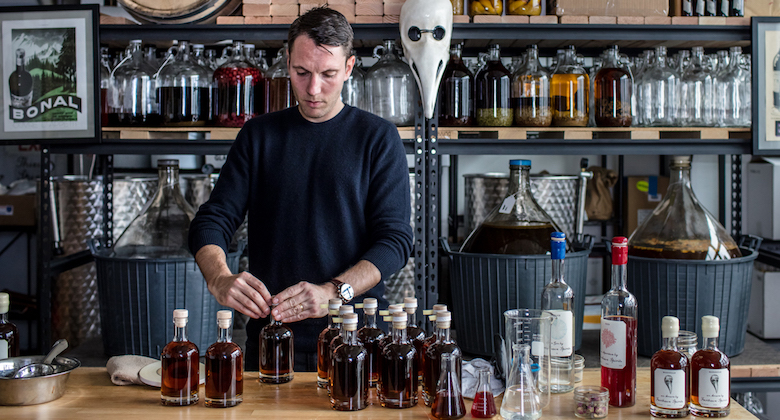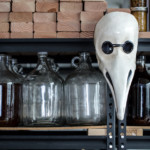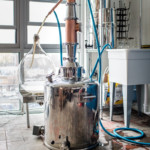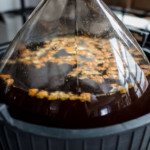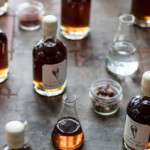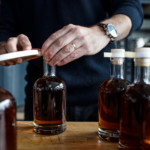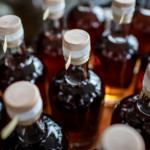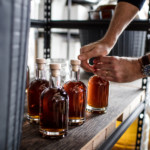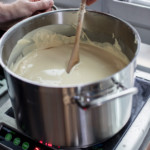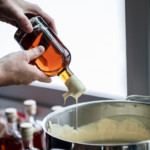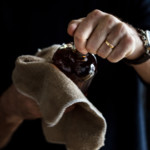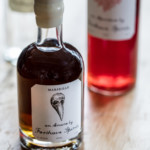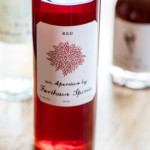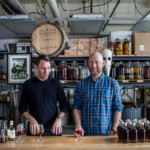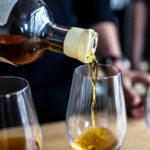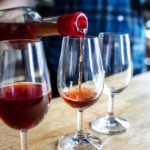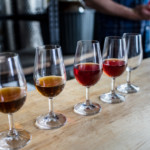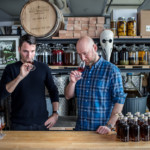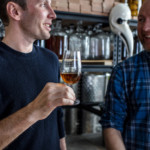
I can’t see Forthave Spirits founder Daniel de la Nuez when I walk into his Williamsburg, Bed-Stuy border micro-distillery. What greets me instead is a smirking black-and-white plague doctor mask hanging from a shelf and music so loud he can’t hear me knock from where he’s kneeling, clad in gloves and apron, working.
“I grew up on hip-hop and punk in New York,” the Brooklyn native tells me on an apocalyptically warm February day in his Pfizer Building space. “Do it yourself and figure it out. Don’t get a ton of investment and hire a bunch of people. If you really want it to be sustained through 30 years, you learn the entire process.” Next to him, a pot of white wax bubbles over a single electric burner, soon to be used as a seal.
This DIY punk approach to spirits has resulted, so far, in three very polished bottles: “Red,” an aperitivo; “Blue,” an American dry gin; and “Marseille,” an amaro. The link between each is a focus on botanicals, but it was the amaro that inspired the former film and TV producer to start distilling three years ago. The full launch just happened in January of this year.
The journey started one night when, while having a round of the herbal liqueur, a friend mentioned he was making some himself. It piqued de la Nuez’s interest, who offered his house as a workshop. “We started messing around, playing with recipes and came up with some really good things,” he tells me. “I was like, ‘Someone should be doing this.’” It didn’t take long for him to realize he could be that someone.
Amaro simply means “bitter” in Italian—and that’s about the only point of agreement on the category, according to Brad Thomas Parsons’ book Amaro: The Spirited World of Bittersweet, Herbal Liqueurs. There are some makers in Italy who would like to see a Denominazione di Origine Controllata (D.O.C.) protection of the sort that makes it so in the European Union you can’t call any old cheese Parmigiano-Reggiano. But amaro doesn’t have a set recipe. Regional blends in Italy showcase distinct botanicals according to preference and availability.
“Every part of Italy—every region, every town, you go into a restaurant and they have their own. As you travel and get more amaro, no one tells you what’s in them,” de la Nuez tells me of his own research. “They’ll say, ‘Oh, there’s some saffron, some eucalyptus.’”

De la Nuez has created his Marseille amaro on the basis of “the secret recipe of four medieval thieves.” The distillery’s name comes from Richard Forthave, who, according to legend, developed an herbal tonic for these thieves to protect them from the disease when they wanted to rob a plague-ravaged ship that had traveled from Tripoli to Marseille (hence that mask in the office and on the bottle, the latter designed by designer and collaborator Aaron Fox). His blend actually helped, but it wasn’t for the immunity-boosting reasons Forthave intended; its antibacterial properties kept away fleas, which were the carriers. “It’s a horrible thing to say the plague inspired a lot, but it really did.”
The Forthave amaro blend features cinnamon, eucalyptus and honey. It has depth, warmth and a mellow sweetness, with a bitterness that doesn’t take over. De la Nuez, whose father is Spanish, had a head-start on American palates when it comes to enjoying bitter flavors (don’t put sugar in his espresso). “Bitter was something that was in my household always,” he says. “I’ve also found out that maybe for some it’s newer, but I’ve had some people say they expected it to be a lot more bitter.”
With his amaro, aperitivo (a superb Campari alternative) and gin finding their places in the market now, he’s working on a series of limited-run bottles—perhaps a fernet, or a barrel-aged aperitivo—which he likens to an artist’s series of prints or a small natural wine producer who “creates elegant, single-batch vintages from particular, small plots of land.” Whatever he chooses, we’re confident it will be elegant, both in design and flavor.


